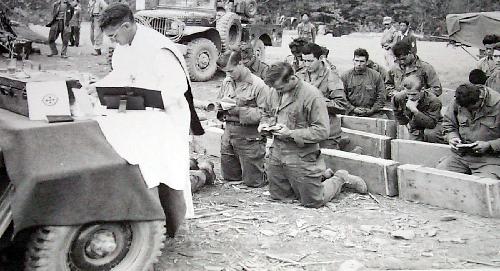Kneeling at Mass can be a controversial and divisive issue among liturgists and I have no intention of wading into the debate. However I think that kneeling and all our liturgical postures contain deep meaning and significance. First, kneeling is not something that we normally do in day to day life. When we kneel we are physically demonstrating that what happens at the Mass is sacred and different from the rest of our daily lives. Furthermore kneeling is a sign of adoration and reverence.
 We kneel during the Eucharistic prayer as this is the most important part of the Mass; it is when Our Lord becomes present in the Blessed Sacrament. Many would argue that this is an innovation of the medieval ages, when people would adopt similar postures in the presence of their social superiors. This might be the case, but if one is willing to kneel before a king is it not acceptable to kneel before the King of kings?
We kneel during the Eucharistic prayer as this is the most important part of the Mass; it is when Our Lord becomes present in the Blessed Sacrament. Many would argue that this is an innovation of the medieval ages, when people would adopt similar postures in the presence of their social superiors. This might be the case, but if one is willing to kneel before a king is it not acceptable to kneel before the King of kings?
 We kneel during the Eucharistic prayer as this is the most important part of the Mass; it is when Our Lord becomes present in the Blessed Sacrament. Many would argue that this is an innovation of the medieval ages, when people would adopt similar postures in the presence of their social superiors. This might be the case, but if one is willing to kneel before a king is it not acceptable to kneel before the King of kings?
We kneel during the Eucharistic prayer as this is the most important part of the Mass; it is when Our Lord becomes present in the Blessed Sacrament. Many would argue that this is an innovation of the medieval ages, when people would adopt similar postures in the presence of their social superiors. This might be the case, but if one is willing to kneel before a king is it not acceptable to kneel before the King of kings?Kneeling is also a posture of humility and penance. Often in the Old and New Testaments we see individuals get on their knees to demonstrate their remorse. Humility is not a prized virtue in our society which often focuses on putting one’s self at the centre of life, rather than God. Christianity, on the other hand, has always prized humility as the way to Heaven, in imitation of Christ who humbled himself to come among us as human in order to restore us to communion with God.
Kneeling is also a posture of intimacy. When Christ was suffering the agony in the garden he shared his intimate prayer with the Father on his knees.And it is also a gesture of trust. We are vulnerable and at a disadvantage physically but we can trust in God, and the Blessed Sacrament is the embodiment of that trust.
The Catholic Encyclopedia includes a very interesting article on kneeling. You can read it on the New Advent website, here.
Kneeling is also a posture of intimacy. When Christ was suffering the agony in the garden he shared his intimate prayer with the Father on his knees.And it is also a gesture of trust. We are vulnerable and at a disadvantage physically but we can trust in God, and the Blessed Sacrament is the embodiment of that trust.
The Catholic Encyclopedia includes a very interesting article on kneeling. You can read it on the New Advent website, here.
"An innovation of the middle ages". Funny. An innovation only 800 or so years old.
ReplyDeleteGood thoughts. Some of us do kneel on a daily basis in everyday tasks too though.... Washing the floor, talking to small children, fixing stuff. Even as a secondary school teacher it was surprising how often you could find yourself kneeling at a students desk to help them with their work at a comfortable height! Kneeling in Church is different because the intention is different? Like you say, it is a gesture of trust and, for me anyway, a prayer within itself. My mind can be all over the place during Mass, I am easily distracted, but kneeling is a bodily prayer which it is much harder to be distracted from!
ReplyDeleteI like a lot of people in my parish are aging with conditions that make kneeling imposable like gout or lumbago or just plain leg arthritis would it be better to have a no kneeling section in the pews then not having the people who physically can't kneel not come to Sunday mass at all.
ReplyDelete